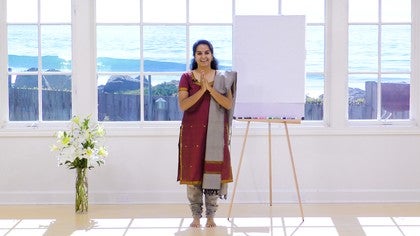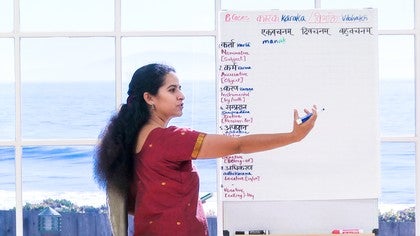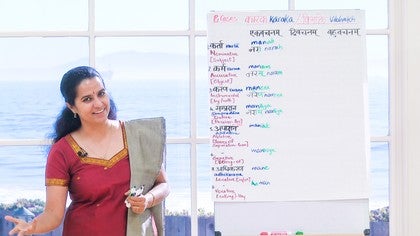Description
About This Video
Transcript
Read Full Transcript
Namo, namah, dear friends, swagatam again. I hope you've been following along and enjoying this exploration of Sanskrit and its different dimensions. We've got the nouns in place, we have the pronouns in the singular dual plural, then we've looked at certain verbs. You're building your vocabulary gradually and if you start looking at text, you'll see that you'll start recognizing the grammatic forms of the words within what you're reading. Next what we'll have a look at is a very big and very important part of the Sanskrit grammar and that is the noun cases.
We had briefly mentioned it during the introduction to the language building where we spoke of eight cases in a language. In Sanskrit specifically, what I'd like to do here is to help you understand the logic behind the importance of these cases. So when we talked of a sentence, what was the very basic building block of a sentence? We had a subject and a verb, right? That is the person who does a particular action.
Maybe as a title, I will just mention that it's the eight cases here so you know what we are discussing in this section. So let's take a very simple sentence. How about she goes? Let's write that out. She goes.
Now if I had to draw this out, it could be like that. So let's have a beautiful lady walking. So she goes. Now if that's a lady walking down, she goes. What are the questions that come to your mind?
So she goes. What is one of the important questions that follow? Where does she go? So let's mark that in a separate color so that it is clear. So the question is where?
And since we all belong to the yoga world, we make it very simple. She goes to the yoga center. So to the yoga center. Another question that can come up around the verb to go, I'll just mark that out. That's what we are discussing.
Another question that is important is from where? Because the moment you're talking of a destination, the question about the origin comes to mind. So from where? And again to keep it very simple, we'll say from a house or from home. Now let's put those two details into our picture.
So you see first when you have just the simple sentence, it corresponds to a certain image in your mind. The moment you start building on the questions around the particular verb, you are also bringing in more precision in the picture that is forming in your mind. So when we said that she's going to the yoga center, we'll take her to one of my favorite yoga centers, which is the Lulu Bandhas. Have a nice garden there and you can't miss out on the grandlady sitting there now. Leg there, yeah you got it and let's put it in there clearly, Lulu's.
Alright so she's headed to the Lulu's yoga center and where is she coming from? She's coming from home. So we have some more pictures clearer there now. So we'll give her her house there, yeah and that's good. Here there is a nice garden here as you know, if you've been around Ojai you would know it's a very beautiful little place, that's it, fine.
So she's going from a house to the yoga center. Now what are the other questions that arise in the mind? Another question is how is she going there, right? So let's put that in. So how?
And to keep it in tune with our yogic effort, she's going there by cycle. Now let's try and draw a cycle there, a little bit of the black, wheels there, a little bit of black, how's that? Alright so she takes a cycle and she's going to the yoga center. Now some other questions that come up there, so you can ask with whom? And we can answer with a friend.
So we'll put the friend in there, they're both happy to be on the way, great. And then the other important question is when, when is she going there? So when do we take her there, we'll take her there in the morning, alright. So when and the answer in the morning, morning and the last but not the least, why is she going there? The answer to which is again very obvious in the yoga world, for good health.
One of them, you can go there to open your heart, you can go there for many other reasons, but we'll take the one for good health at this stage. So why? For health, there we are. Now there is another kind of question that you can ask, which is a question that says belongs to? You can ask for example, whose home, whose yoga center, whose cycle, but that's another level of question.
It's not a direct question with the basic sentence that we have here. So you can say whose cycle, whose friend, whose yoga center, etc. The other kind of question that does affect the way the verb works is how many of them are going. But at this stage, we'll keep it simple and we'll just talk about one person who's going with her friend. So I'll just mark it in there so that we know it's another option.
So how many? Because that will change how that basic sentence is structured. Now let's see what we have. We said in the morning, I've not put that into the drawing. So we are in the morning and because it's Lulu Bandhas, we have the mountains all around it.
Yeah? So you see what we have done basically, we started out just with a simple sentence and that corresponded to only the picture of the girl walking down, the lady walking down. The moment we started asking all those extra questions, the picture that we were building or the picture that we were drawing for our listener started getting more and more precise and more and more elaborate. Now let us put that whole thing into a sentence. So the sentence that we will draw right here is, let's write that.
So she or we can say probably the girl just to make it or the lady in this context, the lady, okay. So the lady, the lady goes, now you can start helping me with this now. So she goes where, to the yoga center, to the yoga center, from home, okay, I'll just put one thing like that, from home. How is she going there? By cycle, by cycle with a friend, got that?
So we have done this, we have done with this, by cycle from home in the morning, in the morning, for health. So do you have that now? That's the basic sentence that we have built, right. So here what you see is that we have to keep these combinations together in English because if I said the lady goes from the yoga center, you will have a completely different meaning. The word yoga center said by itself does not give you the information, whether it is the destination or whether it is your starting point, got that.
So you have to keep this combination of prepositions with the word in order to get an understanding of what the yoga center represents in your picture from home. So this is the origin, point of origin, by cycle, that is the instrument, with a friend, that's the company. So with, in the morning, the time, when, and what is the reason, why, for health, great. Now like I mentioned to you earlier when talking of the language building, what Sanskrit does is that it incorporates the prepositions into the word itself and it, the word therefore becomes complete in the meaning it represents in your idea, I'll build it for you. So we have the lady goes to the yoga center.
So the yoga center, I'll just give you the ending in Sanskrit now, we'll keep the English words. So you will see how the idea really builds. The lady goes to the yoga center, so if the word yoga center was there, so yoga center and because it is the destination, we have to add a sound at the end. So all this to the just gets transformed into. So yoga center, for example, we'll play with the English.
So the lady goes, yoga center would mean to the yoga center, from home. The word or rather the addition at the end is, it's the art. So like I said, we are playing now, alright, so would mean from home, by cycle. So we'll say, we'll use the word, we'll keep it in the masculine now, so it just looks easy to start with. So we'll, the word for cycle in Sanskrit in the masculine would have an ending which is sorry, cycle and then ena, cycle ena with a friend.
Now both these get the same kind of an ending, with and by have the same kind of an ending. So it'll be, you got it, friend, give the same ending, friendena, in the morning. So the in the morning will get an ending a, morning a and for health, for gets added in the masculine or the suffix for for in the masculine is ayah. So health will become, health ayah. So there we go, what is the first thing that you have observed here?
You had so many words in the English language, when you reduce them by bringing the preposition or incorporating the preposition as a suffix to the noun itself, suddenly the number of words that are used are drastically reduced. So let's just say it in English once, the original sentence. The lady goes to the yoga center from home by cycle with a friend in the morning for health. Now let's do the Sanskritized version of the English. The lady goes yoga kendram or yoga centrum, homat from home, cyclena with the cycle or by cycle, friendena with the friend, morninge in the morning, health ayah for health.
Now I'll replace the English words with the Sanskrit and we'll see how the Sanskrit forms. So I'll write it out in transliteration to keep life rather simple here. So the lady in Sanskrit that we have already seen is naa. Remember when I said she is the one who is doing the action, she gets the long ee, naa ee, goes, you got it, gachati, gachati. Yoga center, the word for center is kendra, so yoga kendram, homat, the word for home or house that we have looked at is griha, so it will be grhahat by cycle.
So cycle, the masculine word for that could be dvichakraha, two wheels. So dvichakrena, friend, you know the word, mitra. So when you add that it will be mitraena, very good, mitraena. Word for morning is pratah, pratah kala is morning. So pratah kale, that's it, pratah kale and then health, the word for health is very beautiful.
I'll explain to you in a short while, is swasthyam, so there we go. So what we've done is, we have now written out the Sanskrit sentence for the description that we have drawn here. We read the Sanskrit as written here, nari, gachati, yoga kendram, grhahat, dvichakrena, mitraena, pratah kale, swasthyaya, for good health. Like I said, let's observe what it does in terms of the number of words in that sentence. In English we had 1, 2, 3, 4, 5, 6, 7, 8, 9, 10, 11, 12, 13, 14, 15, 16, 17, 18 words to describe this entire picture that we have here.
When we do it in Sanskrit we have 1, 2, 3, 4, 5, 6, 7, 8 words. So you see how concise the language starts becoming when you represent it like this in Sanskrit. So actually the adding of the preposition at the end of the word really makes every word very compact. The other beautiful aspect of this kind of an arrangement of the word is that, like I mentioned in the English case, if I said the lady goes from yoga center in friend by morning from health, you can't jumble the order of the words because it will just not make sense. Every word has its independent meaning, it is not connected to the others as it stands.
Now when we have done it in Sanskrit, yoga kendram will always tell us that it's the destination or rather, grihaat will tell us always that it's the source. So it doesn't matter at all in which order you have framed the sentence. You can start with nari pa, what's a pratah kale yoga kendram, mithrena, dvicha kri kena, grihaat, swasthya ya gachati, perfectly the same or you can start swasthya ya yoga kendram, dvicha krena, grihaat, mithrena, pratah kale, nari, gachati and you have the same sentence because every word is complete in the way it is corresponding to the other words around it. So when you are saying something in Sanskrit, what it tends to do is it helps you organize your words or organize the world in a manner that you really start getting a great clarity of how things are related to each other in your head as well as in the way that you present it. So each of these different endings represents a different case which I will shortly show you but before we complete this particular section, another sweet characteristic of the Sanskrit language is how its words are formed.
So we have a word here, swasthya, it's with the ending there but it's the word in the newtas, swasthyam, which means health or when we talk of somebody's healthy, it is swastha. Now the word swastha is combined of two words, it's swa and stha, swa and there is a stha there, okay this is you should know it's a combination there, swastha, so swa means oneself and stha means established. We saw it for the root uttishtati to stand, the stha there is in play here. So swastha means one who is established in themselves, who is that self in which one is established or where one is established. Understanding from the yogic tradition, we know that it is only when one is in total alignment with one's deeper self that good health would be a natural consequence.
So swasthyaam is the quality of being established in the deepest of oneself and very interestingly when we talk of treatment therefore, the word for treatment is chikitsa, chikitsa, I can just write it for you here, chikitsa which is treatment, chikitsa is a form of the verb a kit which means consciousness, chikit makes it or rather gives it the form looking for the right consciousness. So when you are off balance and not feeling well, the way to heal yourself or to treat yourself is to just try and identify the right alignment within the right consciousness and you will be in perfect health. Many ways of being in perfect health and one that I can guarantee you that can help as a good medicine is to just sound the Sanskrit letters or just go through the Sanskrit spoken aspect of the language, speak it, enjoy the benefits of the power of its sounds within your system. Let's do more of this as we go down together on this journey of discovering the wonder that is Sanskrit, come along, practice it and you'll do very well. Namaste.
Mother Tongue: Nouns
Comments
You need to be a subscriber to post a comment.
Please Log In or Create an Account to start your free trial.










